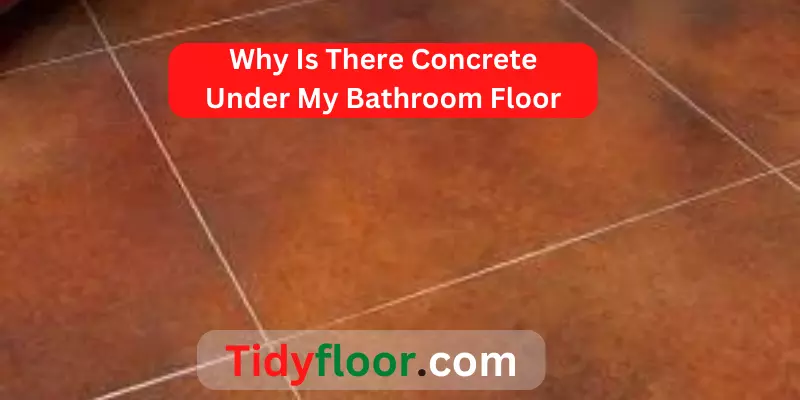Concrete is used on the floor of all our bathrooms. However, if the floor is installed on a concrete subfloor, it often cracks. One of the causes for this is concrete under the floor. Then the question comes to our mind why is there concrete under my bathroom floor?
The reason for leaving concrete under the floor is improper cleaning and poor construction. If the subfloor is not cleaned properly, concrete can remain under the floor. If you install the floor directly on the concrete subfloor, this can also be a problem.
There are numerous other reasons for leaving concrete under the bathroom floor. Read this article to know all of the possible explanations. Here I will also share the cause of the problem and its simple solution process. It will be helpful for beginners also.
7 Reasons Why Is Concrete Under Bathroom Floor
If you do not install the floor properly, it will not last long. Sometimes the concrete remains under the floor, and it cracks with light pressure. However, if you know why concrete is under the floor, you can get rid of this problem. So, below are some of the reasons for this problem.
1. Improper Cleaning
It is significant to clean the floor well before installing the floor. Otherwise, the concrete may go under the floor and cause cracks in the floor. So first, sweep or vacuum the floor and make sure there are no dirt in it.
Then you have to scrub and wash the floor well. Thus, there will be no prospect of any concrete under the floor. If any concrete remains under the floor, it may be the main cause of floor cracks.
2. Wrong Placement
If you have no working knowledge about the flooring project, it can damage due to incorrect placement. If you do not install the floor properly, the concrete can go down. So, it is significant to know the exact process before installing the floor.
It is vital to start from the accurate area to install the floor. If you install it in the wrong place, you will not notice anything left on the floor. However, once the floor is fully installed, it will look uneven and crack easily.
3. Poor Construction
Any critical word requires skilled hands. Never hire unskilled workers to install the bathroom floor. It may encounter various problems on your floor. Due to their poor construction, concrete or dirt remains under the floor.
Also, many people are not able to arrange the floor pattern properly. So, even if the cost is high, skilled workers should do the floor work. This will make your floor long-lasting and attractive.
4. Not Applying Sealer
Someone recommended installing a floor straight on the concrete subfloor. As a result, the floor is uneven due to the concrete underneath, and the tile breaks under low pressure. So, I think sealers should be applied to the floor previously to install the tiles.
Sealers are quite suitable for floor maintenance of any floor. This will level your floor, and you can see if there is any concrete left below. Moreover, if you apply sealer on the concrete, it will hold the floor firmly.
5. Control Joints
Concrete control joints are a prerequisite for floor cracks. There is a threat of breaking if the tile is installed. It is also the weakest place in concrete. If you install the floor in these places, the concrete will crack the floor.
As a result, after the floor is installed, the concrete under it will leak and crack. So, a subfloor should be made in all these places, and the floor should be installed. Though, it is well to not install the floor in control joint places.
6. Cracks Not Patching
Tiles are often installed to protect the floor from cracks. However, before installing the concrete floor, you must patch all the cracks. Because there is concrete left in the cracked part a lot of the time, which we don’t notice.
As a result, if there is pressure on the crack, it will burst completely. This is mostly due to the concrete under the floor. So, patch all the cracks to install the floor.
7. neven leveling
Installing tiles on uneven floors can lead to cracks. Also, if the concrete remains on the uneven floor, it will not be noticed during the tile installation. However, if there is pressure on the floor, the tiles of that place will burst.
So, level the subfloor before installing the tile on the bathroom floor. If necessary, scrub the upper part and make it equal. Also, if you apply the sealer to the floor, its surface can be plane.
5 Simple Steps To Remove Concrete From Under Bathroom Floor
If concrete remains under the floor, it can cause cracks. When you notice concrete or any other object under the floor, it is important to remove it quickly. Below is the process of removing concrete from the bottom of the tile floor.
Step-1: Assemble Necessary Equipment
To remove the concrete under the floor, the tiles of that place have to be removed. So, there are a few tools that will work on floor cleaning and tile removal. You must have these tools at your fingertips to get started.
- Grout Removal Tool
- Hammer
- Chisel
- Scrubber
- Vacuum
- Glue (For Reinstall)
- Grout (For Reinstall)
- Moist towel
Step-2: Remove The floor
You need to pick up the floor to remove the concrete under the floor. For this, scrape the grout around the tile. Scarp on it a few times with a grout removal tool. Then gently remove the floor with a hammer and chisel.
Step-3: Clean The Floor
Once the floors are removed, clean the bottom part well. With the help of a chisel in the first place, remove the cement stuck in it. Then with the help of a scrubber, clean the remaining cement, and wash and dry the floor. Carefully place it as it will be reinstalled.
Step-4: Remove Concrete From The Floor
Now it’s time to remove the concrete on the floor. First, vacuum the floor thoroughly. Then remove the concrete and cement from the floor with a chisel and hammer. If necessary, wash and dry the floor. However, make sure that the floor level is flat. If there is any crack in the floor, fill it and make sure that there is no concrete on the floor.
Step-5: Reinstall The Floor
You can reinstall the floor if you are sure there is no more concrete or dirt on the floor. But before that, let the floor dry completely. Can’t stick glue on a wet floor. Once the floor is set, apply grout in the middle again. And when it starts to dry, wipe the top of the tile with a moist towel.
Frequently Asked Questions:
How Do You Remove Concrete Subfloor?
To remove the concrete subfloor, you must first dismantle the bottom. Be sure to bring personal protective equipment with you when you do this. You can use a pre-bar to break down the concrete. Break the concrete subfloor with a hammer after emptying the bottom of the concrete.
Spread a plastic sheet over the broken concrete so that it does not hurt anyone. Remove broken concrete for work convenience. Repeat the process to destroy the entire area on the concrete.
What Goes Under Your Bathroom Floor Tiles?
Before installing bathroom tiles, you need to use a few essential components. But first, you need to generate a subfloor as part of its structure layer. You can use uncoupling membranes to install tiles on concrete. This helps prevent tile movement.
Professionals are applying a thinset layer and installing backer boards on it. This board is screwed to the subfloor. Then extra coating of thinset is applied on upper of it, which is a kind of glue. Tiles are installed on top of this glue.
Do You Need Underlayment For Tile On Concrete?
It is unnecessary to use any underlayment to install tiles on concrete floors. However, you need to create a strong subfloor as a floor structure layer. It is not right to fit straight on the concrete.
Concrete uneven areas can damage the tile. So, make a subfloor above the concrete floor before installing the tiles. You can use backer boards to install tiles on top of concrete.
Can Concrete Be Used For A Bathroom Floor?
Concrete works quite well on bathroom floors. It does not get dirty as fast as ceramic tiles and is easy to clean. Another advantage of this is that water can not harm. There is a risk of slipping if water falls on some tiles.
However, if you use concrete on the bathroom floor, it will be less slippery. It is a maintenance process, much like ceramic tile. But the cost of concrete is relatively low, and it is long-lasting.
Why Is Concrete Used Under Bathroom Floors?
Concrete is commonly used as a foundational material under bathroom floors for several reasons. Firstly, concrete provides stability and support to the floor structure, ensuring it can withstand the weight of fixtures, such as toilets, bathtubs, and showers. Secondly, it acts as a barrier against moisture, preventing water damage and leaks from reaching the underlying subfloor. Additionally, concrete helps with sound insulation, reducing noise transmission between floors. Lastly, it offers durability and longevity, making it an ideal choice for high-moisture environments like bathrooms.
Can I Install Tiles Directly On The Concrete Under My Bathroom Floor?
While concrete provides a sturdy base, it is not typically suitable for directly installing tiles. Concrete surfaces may not be perfectly level or smooth, which can lead to uneven tile installation and potential damage over time. To ensure a proper tile installation, it is recommended to prepare the concrete surface by leveling it and applying a thin layer of mortar or a cementitious underlayment. This creates a smooth and even surface, allowing for successful tile installation and ensuring long-lasting results.
Is It Normal To Have Concrete Cracks Under My Bathroom Floor?
It is not uncommon to find minor cracks in the concrete under your bathroom floor. Concrete can develop small cracks due to various factors, such as settling of the building’s foundation, temperature changes, or shrinkage during the curing process. However, if the cracks are extensive, widening, or accompanied by signs of structural issues like uneven floors or water leaks, it is advisable to consult a professional to assess the situation. Prompt attention to significant cracks can help prevent further damage and ensure the integrity of your bathroom floor and the overall structure of your home.
Final words
The subject of this article was ‘Why Is There Concrete Under My Bathroom Floor’. I hope you know the reasons so far. However, if you are not careful, even after knowing the reasons, you will not be able to prevent floor damage.
Therefore, hire skilled workers to install the floor. However, if the problem does occur by mistake, quickly remove the concrete from the bottom of the floor by following the steps above.


